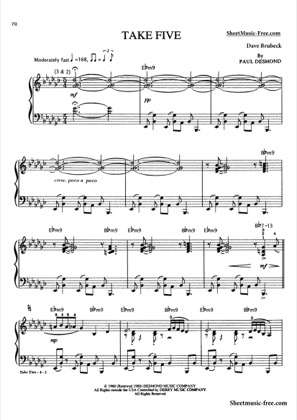
Justin London is a professor of music at Carleton College in Minnesota who specializes in music perception and cognition, particularly with respect to musical meter.

"It seemed very natural to them to be playing in this rhythm," Langham says. Within his travels he would go and hear other musicians and hear what they were doing, and he would incorporate that into his music." In the case of "Blue Rondo a la Turk," Brubeck picked up the rhythm from street musicians in Turkey. Langham says that Brubeck "was a very worldly person. Of course, novelty is in the ear of the beholder. It even gets a bit more complicated: for most of the piece, there are three measures of the unusual 9/8 rhythm followed by one measure of the usual groups of three. In 9/8 time, the nine eighth notes are usually divided into three groups of three, with the stress pattern one two three one two three one two three, but "Blue Rondo" has the pattern one two one two one two one two three. "Blue Rondo a la Turk" has a time signature of 9/8. "This allowed college students to be different, in the sense of adding a funky twist to it." "Take Five," which was conceived by Brubeck's saxophonist Paul Desmond, is in 5/4 with the accent pattern one two three four five, so each measure can be thought of as being split into two uneven chunks. Langham says that from a dance point of view, the meter of "Take Five" combines a waltz and a two-step, both of which were popular in the 1950s and 1960s with the parents of teenagers. 4/4 means that there are four beats and a quarter note lasts for one beat, yielding four quarter notes in each measure.) " Take Five" and " Blue Rondo a la Turk," two of Brubeck's most popular works, are both on Time Out. (The first number, which is the top number of the time signature in sheet music, represents the number of beats in the measure, and the second number represents the note value that receives one beat. Time Out, the hit 1959 album by the Dave Brubeck Quartet, was one of the first popular jazz works to explore meters beyond the traditional 4/4 and 3/4. "He sort of tired of the traditional patterns of jazz," says Patrick Langham, a saxophonist and faculty member of the Brubeck Institute at the University of the Pacific in Stockton, Calif. The pianist and composer was an innovator, especially when it came to combining rhythms and meters in new ways.

It developed from roots in Blues and Ragtime. Jazz is characterized by swing and blue notes, call and response vocals, polyrhythms and improvisation.Jazz legend Dave Brubeck died December 5, just one day before his 92nd birthday. Overview of Style: Jazz originated in New Orleans, United States in the late 19th and early 20th centuries. Part B is played again(4.37-4.51) before part A is played once more for sixteen bars to end the track.

The drum solo is played over the part A chord progression(2.00-4.22). Part B begins after twenty bars and lasts for eight bars(0.36-.0.50). Starts with a five bar drum intro, part A begins with piano chords and bass being introduced during the fifth bar of piano.

Structure: Instrumental record with A and B parts and drum solo. The drums are panned left and the piano to the right, bass and drums are center. Instrumentation/use of Technology: Piano, alto saxophone, double bass and drums. The piano and bass swell from pianissimo to mezzo forte during this solo(3.00-3.25). The drums are played mezzo forte during the solo(2.14). The saxophone varies from mezzo piano to forte. Saxophone melody accompanied by piano chords and bass.ĭynamics/Articulation: The drum intro with piano, both are played mezzo piano. Formed in 1951 by Brubeck and Desmond, Joe Morello joined the band in ’56 to play drums and Eugene Wright was recruited in ’59 to complete the quartet.


 0 kommentar(er)
0 kommentar(er)
